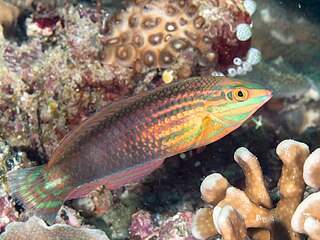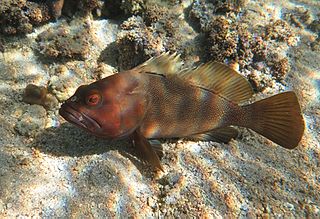
The slippery dick is a species of wrasse native to shallow, tropical waters of the western Atlantic Ocean.

Epinephelus marginatus, the dusky grouper, yellowbelly rock cod or yellowbelly grouper, is a species of marine ray-finned fish, a grouper from the subfamily Epinephelinae which is part of the family Serranidae, which also includes the anthias and sea basses. This species is the best known grouper species of the Mediterranean Sea and North Africa coast.

Epinephelus summana, the summan grouper, is a species of marine ray-finned fish, a grouper from the subfamily Epinephelinae which is part of the family Serranidae, which also includes the anthias and sea basses. It comes from the Eastern Indian Ocean that occasionally makes its way into the aquarium trade.

The honeycomb grouper, also known as black-spotted rock-cod, common birdwire rockcod, dwarf spotted rockcod, dwarf-spotted grouper, honeycomb cod, wire-netted reefcod or wire-netting cod, is a species of marine ray-finned fish, a grouper from the subfamily Epinephelinae which is part of the family Serranidae, which also includes the anthias and sea basses. It has a wide Indo-Pacific distribution where it is found in coastal and offshore reefs in shallow waters.

The seaweed blenny is a species of combtooth blenny found in coral reefs in the western Atlantic Ocean along the coasts of New York, Bermuda, the Bahamas, also in the Gulf of Mexico, south to southern Brazil. This species reaches a length of 8.5 centimetres (3.3 in) TL.

The longfin grouper, also known as the longfin rockcod, bar-breasted rock-cod, Gilbert's rock-cod, honeycomb rockcod, spotted groper or wirenet cod, is a species of marine ray-finned fish, a grouper from the subfamily Epinephelinae which is part of the family Serranidae, which also includes the anthias and sea basses. It is found in the Western Pacific Ocean.

Stegastes leucostictus is a species of damselfish found near the sea bed in shallow waters on the western fringes of the Atlantic Ocean. It is commonly known as the beau gregory or beaugregory.

The red-lined wrasse, two-spotted wrasse or biocellated wrasse, Halichoeres biocellatus, is a species of wrasse native to shallow tropical waters in the western Pacific Ocean.

Epinephelus spilotoceps, the foursaddle grouper or spotty cod, is a species of marine ray-finned fish, a grouper from the subfamily Epinephelinae which is part of the family Serranidae, which also includes the anthias and sea basses. It is found in the Indo-Pacific region.

Genicanthus caudovittatus, the zebra angelfish, swallowtail angelfish, and lyretail angelfish, is a species of marine ray-finned fish, a marine angelfish belonging to the family Pomacanthidae. It is found in the Indian Ocean.

The whitespotted grouper, also known as the rankin cod, ocellated rockcod, small-spotted cod, white-spotted reef-cod or whitespotted rockcod, is a species of marine ray-finned fish, a grouper from the subfamily Epinephelinae which is part of the family Serranidae, which also includes the anthias and sea basses. It has an Indo-Pacific distribution. It is closely related to two other species of white spotted groupers in the genus Epinephelus.

Halichoeres leucoxanthus, commonly called the Canarytop wrasse, Whitebelly wrasse, or Lemon meringue wrasse, is a fish species in the wrasse family endemic to the Indian Ocean.

Epinephelus erythrurus, the cloudy grouper, also known as the cloudy rock cod, is a species of marine ray-finned fish, a grouper from the subfamily Epinephelinae which is part of the family Serranidae, which also includes the anthias and sea basses. It is found in marine and brackish waters in the Indo-Pacific region.

Epinephelus faveatus, the barrel-chested grouper, also known as the Indian grouper, is a species of marine ray-finned fish, a grouper from the subfamily Epinephelinae which is part of the family Serranidae, which also includes the anthias and sea basses. It is associated with reefs in the Indian Ocean.

Epinephelus undulosus, the wavy-lined grouper, brown-lined reefcod, mid-water rockcod, mid-water grouper, is a species of marine ray-finned fish, a grouper from the subfamily Epinephelinae which is part of the family Serranidae, which also includes the anthias and sea basses. It has a wide Indo-Pacific distribution. They are produced through aquaculture and commercially fished.

Halichoeres richmondi, commonly called the Richmond's wrasse or chain-lined wrasse, is a fish species in the wrasse family native from the central Indo-Pacific.

The blackear wrasse is a species of wrasse, a type of fish in the family Labridae, from the warmer waters of the western Atlantic Ocean.

Chaetodon nippon, also known as the Japanese butterflyfish, is a species of marine angelfish found in the northwest Pacific Ocean in the shallow seas around Japan, South Korea, the Philippines and Taiwan.

Epinephelus bruneus, the longtooth grouper, is a species of marine ray-finned fish, a grouper from the subfamily Epinephelinae which is part of the family Serranidae, which also includes the anthias and sea basses. It is found in northwest Pacific in eastern Asia.

Epinephelus rivulatus, the halfmoon grouper, halfmoon rockcod, Chinaman rockcod, Charlie court cod, green-finned rock cod, or white-dotted grouper, is a species of marine ray-finned fish, a grouper from the subfamily Epinephelinae which is part of the family Serranidae, which also includes the anthias and sea basses. It is found in the Indo-Pacific region.





















